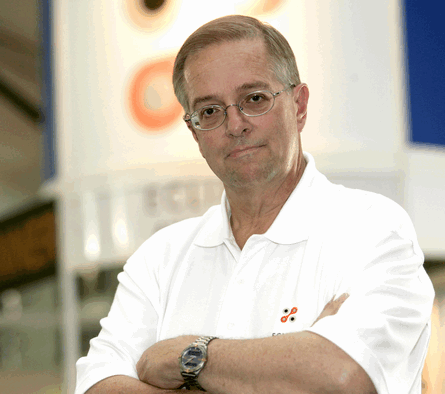A relaxed, bearded and newly jobless Vern Raburn catching up with friends and former colleagues at this month's National Business Aviation Association convention in Orlando cut a very different figure to the amiable, energetic and always quotable visionary who for the past several NBAAs had been updating the world on the faltering progress of the Eclipse 500, the world's first and still biggest-selling very light jet.
Although not short of friends in high places - he had lunch with Bill Gates the day before our interview and has been talking with his friend Sir Richard Branson - the 58-year-old former Eclipse Aviation chief executive, forced to resign in April from the company he founded, is not looking for a new challenge straight away.
 |
|---|
© Eclipse |
"I've had advice from a lot of people and the one consistent thing everybody has said is: 'You have been running a marathon at a sprinter's pace. Take at least six months off. Go through the grieving process'." He says he turned up at NBAA, flying the leased Eclipe 500 he received as part of his severance package, because "I didn't have anything else to do."
A former IT entrepreneur and amateur pilot, Raburn's decade-long marathon began when he came up with his concept for a twin-engined jet that would be more compact and much cheaper than the smallest business jets on the market - at the time Cessna's CitationJet range - and set about forming a company to design and manufacture the Eclipse 500 using volume production processes adopted from the automotive industry.
The Eclipse 500 was always much more than just another aircraft: to Raburn it was an innovation as revolutionary as the personal computer or Model T Ford, capable of bringing fast and affordable private air travel to millions of business people. Late last year, his vision became reality, overcoming the latest in a succession of obstacles to gain Federal Aviation Administration certification and begin deliveries.
But a few months later, in April, the financiers on Eclipse Aviation's board who had pumped in the cash to rescue the ailing manufacturer, demanded the head of the company's founder. While Raburn may have taken the credit for inventing the VLJ and opening the door for manufacturers such as Cessna and Embraer to introduce new entry-level products, he also had to carry the can for a series of gambles that took the Albuquerque-based manufacturer to the brink of bankruptcy.
Raburn accepts mistakes were made, but remains bitter about the way he was unceremoniously dumped from his own company. "Did I see it coming? Absolutely not," he says. The company's financial problems stemmed from decisions taken early in the certification process from which Eclipse struggled to recover. "We screwed up on certification. I have never claimed otherwise," he says. "We took big bets on Williams and Avidyne [the original engine and avionics suppliers which were replaced after problems with their equipment]. Williams cost us up to $200 million and two plus years. Avidyne delayed a lot of the functionality we needed around certification. We were pretty seriously wounded."
But there were other errors of judgement too, including Raburn's attempt to force an automotive or white goods-style just-in-time manufacturing process, based on a global supply chain, on an aviation industry wedded to traditional habits. "We blew the manufacturing start-up process and didn't understand what you have to do to manufacture in high volume. We ran into the buzz-saw of the aerospace supply chain. We thought we could do it the way Sony, Dell, Toyota and Nike do it, leaving your suppliers to build each piece. But when you adopt that strategy, every single vendor must perform," he says.
However, Raburn accepts personal responsibility for the problems. "People say Vern blames the vendors," he says. "The fact is the vast majority have been great, but it only takes one to fail. Eclipse massively mismanaged the process. There was an unwillingness to deal with inventory levels."
Despite all the difficulties, he insists the Eclipse 500 has delivered on its promises and refutes suggestions that short-cuts were taken to begin moving aircraft out of the factory to impatient early customers. "The airplane has to be the safest airplane ever introduced. [Launch customer] DayJet was getting 98% reliability on their newest airplanes. We got our reliability up to where a mature airplane should be. It took Cessna several years to sort the Citation X out," he says.
Although he has been "completely cut off" from the company since his departure, he has every faith that the new management can pull Eclipse Aviation into profitability. "The business plan is very achieveable. I don't believe you cannot mass produce aircraft. It is not a violation of nature's laws," he says.
As for the future, he is debating "diving back in and starting something again" or - more likely given that he is approaching his 60th year - opting for the gentler alternative of offering his services as a non-executive director, mentor or adviser.
"Historically I don't work well for other people," he says. "I really like starting things and I'd say I was uniquely good at doing that." While a return to business aviation seems improbable, the wider industry may still beckon. A business he says fascinates him is space tourism - one of his many claims to fame is that he introduced Microsoft co-founder Paul Allen to Scaled Composites' Burt Rutan - a meeting that ended up providing the funds for SpaceShipOne. He even hints that Branson - whose Virgin Galactic venture plans to offer suborbital flights from 2010 - has offered him a job. Watch this space.
Source: Flight International























